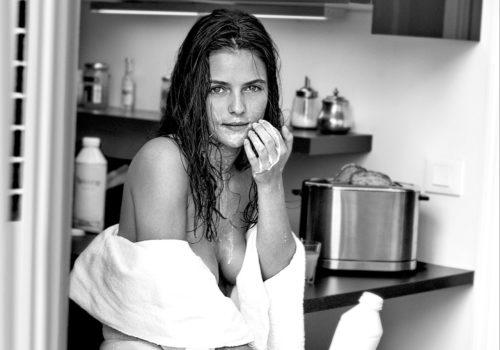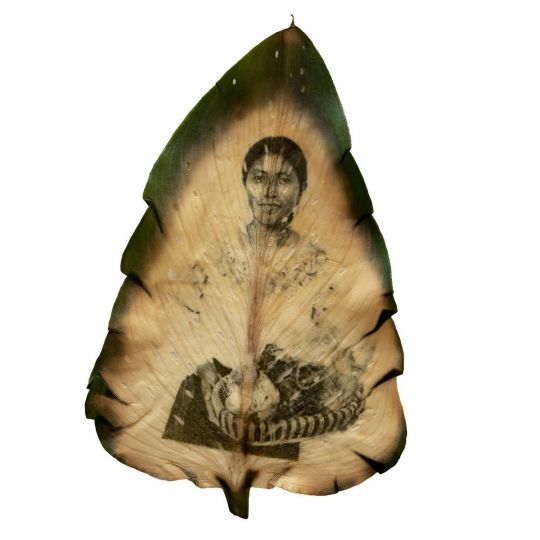Sylvia Galmot : Committed!
Sylvia Galmot: COMMITTED!
Sylvia Galmot freely admits that she didn’t choose photography, but photography chose her. She began her career working for 10 years as a photographer for the most prestigious Parisian agencies, including H&K. This experience enabled her to work with a host of celebrities, including Mélanie Thierry, Isabelle Adjani, Raphaêl Enthoven, Emmanuelle Seigner, Diane Kruger, Léa Seydoux, Andrée Putman, Alain Chabat and Lambert Wilson, to name but a few. Her work has been published by prestigious magazines including Vogue, Marie Claire and Vanity Fair. It’s a recognition that has inspired her to take up fine art photography. If you look at her work, you’ll quickly notice that the essential elements can be summed up in three words: elegance, truth and emotion. Her images are soft, singular and funny too, as she likes to play on the collective imagination.
Sylvia loves useful art, as she herself claims. Very interested in women, and committed to their rights, she campaigns for women to be free and equal (a title she has given to a travelling exhibition to combat violence against women in 2020). This led her to work on what the Parisian woman evokes. But before that, following an encounter that upset her, she became interested in transgender people. By creating a series with these women, she wanted to highlight their beauty and prove that they were something other than « freaks ». In general, her shots, whatever they may be, are marvelously staged, and thrive on the complicity she cultivates with her subjects. The result is impressive truth.
Instagram : @sylviagalmot
What was your first photographic breakthrough?
Sylvia Galmot: When I was a teenager, my favorite aunt was a Franciscan nun in Spain. I saw her once a year. I was captivated and fascinated by her commitment and beauty. I borrowed my parents’ Kodak camera to photograph her.
The man or woman who inspired you?
Sylvia Galmot: Gisèle Freund. A great portraitist of artists and writers. She sought to sum up an entire personality in a single photo. Her most famous portraits are of the great writers of her time. André Malraux, Virginia Woolf, Sartre, Simone de Beauvoir, Colette, Marguerite Duras….
The image you haven’t made yet that you’d like to?
Sylvia Galmot: There are several. Photographing Catherine Deneuve, Jodie Foster, Julia Roberts, Annie Ernaux, Michèle Perraut and others….
Which one moved you the most?
Sylvia Galmot: In 2021, I photographed prisoners. Taking a portrait of 76-year-old Marguerite in her cell (first name changed). The unforgettable encounter with this elderly inmate in her cell, her simple gesture of offering me a cup of coffee, touched my heart deeply. Photography can capture this humanity, vulnerability, and generosity, making it a powerful and very moving image for me. Deep emotion, a moment of genuine human connection in an unusual context.
The one that made you angry?
Sylvia Galmot: The intimate photos of Laure Manaudou published by her ex after their break-up.
A key image in your personal pantheon?
Sylvia Galmot: The portrait of Patti Smith. You can see the little girl, and her smile and gaze bring the captured image to life.
A photographic memory from your childhood?
Sylvia Galmot: Me, when I was about 5 or 6, in a photo booth. I didn’t want to laugh because I’d lost my central milk teeth. My mouth was pinched shut until my brother made me burst out laughing. I still have those two little photos of me in a drawer.
The image that obsesses you?
Sylvia Galmot: I’m not obsessed by any image, but there’s one in particular. You’ll understand why I captured it with my retina. My father died of a nosocomial infection in hospital. I spent a long time alone with him in the death chamber. Sometimes, in the absence of my camera, it’s my eyes that act as lens, capturing incredible moments with my retina.
With no budget limit, what would be your dream work of art?
Sylvia Galmot: With no budget limit, my wish would be to acquire the most expensive work in the world, in order to resell it and dedicate all the funds raised to building shelters around the world for abused women who don’t leave their partners because they can’t afford to and don’t know where to go. And other humanitarian causes that need help.
What do you think makes a good photographer?
Sylvia Galmot: A photo that creates emotion is a good photo. So a good photographer makes images that create emotions.
The secret of the perfect image, if it exists?
Sylvia Galmot: If the perfect image existed, it would tell a story that conveyed a profound message, encouraging viewers to reflect and act within their means to move towards a better world, towards lasting peace.
Who would you most like to photograph if you had the chance?
Sylvia Galmot: Oprah Winfrey!
The photographer by whom you would like or would have liked to have your portrait taken?
Sylvia Galmot: Richard Avedon, the master photographer of portraits and contrasts. If not, Annie Leibovitz, it’s still possible.
A must-have photo book?
Sylvia Galmot: « Humans of New York » by Brandon Stanton. This book presents a collection of portraits of people encountered on the streets of NY, accompanied by brief stories about their lives, dreams and challenges. It captures human diversity while highlighting the experiences that bind us all. The compassion and empathy shown by Stanton in his interactions with his subjects could be a source of inspiration for those who love portraits that celebrate the beauty and dignity of each individual, while promoting understanding and peace in the world.
What was your childhood camera?
Sylvia Galmot: A very simple polaroid. You had to apply yourself to take a picture, because films were expensive.
The one you use today?
Sylvia Galmot: A Nikon.
What’s your favorite drug?
Sylvia Galmot: My mother’s smile. And my daughter’s.
What’s the best way for you to disconnect?
Sylvia Galmot: Go for a long brisk walk without my laptop.
What is your personal relationship with images?
Sylvia Galmot: For me, an image is much more than a simple visual capture. It’s a form of artistic expression that allows me to capture the essence and beauty of each person I photograph. My relationship with images is one of respect and empathy. I strive to create authentic portraits that reflect the dignity and humanity of my subjects.
What do you see when you look at yourself in the mirror?
Sylvia Galmot: I see much more than my physical appearance. I see a person who continues to evolve every day. I’m reminded that true beauty lies in kindness and the way we touch the lives of others.
Your greatest quality?
Sylvia Galmot: Courage.
Your latest folly?
Sylvia Galmot: To have been the first photographer to exhibit on the gates of the Palais de Justice on the Ile de la Cité in Paris for International Women’s Rights Day, « LIBRES ET EGALES ». Twenty eight portraits of women, each carrying a message of hope for freedom and against violence against women.
An image to illustrate a new banknote?
Sylvia Galmot: The portrait of OLYMPE DE GOUGES.
The job you wouldn’t have liked to do?
Sylvia Galmot: Bailiff or war photographer.
Your greatest professional extravagance?
Sylvia Galmot: Exhibiting my portraits of inmates at the Conciergerie in Paris. A place steeped in history, where Marie Antoinette and Olympe de Gouges were imprisoned, a queen and a revolutionary who both had the same life ending. The exhibition would have a powerful symbolic and artistic dimension, blending the history of the place with the contemporary realities of imprisonment. It would make sense to choose such an emblematic place to provoke deep reflection. It’s my next bold and significant professional extravagance.
What are the differences between photography and art photography?
Sylvia Galmot: Art photography is a form of artistic expression that goes beyond reality. The emphasis is on creativity.
Ordinary photography aims to capture moments or scenes from everyday life in a realistic way.
What city, country or culture do you dream of discovering?
Sylvia Galmot: I dream of discovering the Inuit, their remote and mysterious land, their Arctic way of life, their rich culture.
Discovering their igloos, temporary shelters built from blocks of compacted snow, their culture, and traditions. The Inuit have a deep and respectful relationship with nature. It would be a very enriching experience for me.
The place you never tire of?
Sylvia Galmot: The Louvre!
Your biggest regret?
Sylvia Galmot: My biggest regret is a very personal one. It concerns a man. But I’ve learned a valuable lesson from this ordeal.
In terms of social networks, do you prefer Instagram, Facebook, TikTok or Twitter, and why?
Sylvia Galmot: I prefer Instagram because it’s an image-based platform. It’s an efficient way of sharing my work. I have two accounts. One for my portraits and the other for my artistic photographs on different themes such as: “La Parisienne, Paris est une Femme, La parisienne de Pierre Cardin dans mon objectif”, my SEQUENCES series on mythical feminine scenes from cult films, my series at Maxim’s done in 2016 with Pierre Cardin…. As you can see, women are at the heart of my life and my work.
Color or B&W?
Sylvia Galmot: I love both, but I prefer B&W. By removing the distraction of color, you can concentrate more on the emotions.
Daylight or studio light?
Sylvia Galmot: Since 2017, I’ve deliberately chosen to use only natural light for all my portraits. It’s my personal way of contributing to the preservation of our planet. My « Less is More » philosophy reflects both my ecological and artistic sensibilities. More than anything, I like to emphasize that beauty can be found in simplicity and purity. For me, less waste means more creativity. So, I’ve learned to make efficient use of natural resources to reinforce authenticity in my photographic work while making a concrete ecological gesture.
What do you consider to be the most photogenic city?
Sylvia Galmot: It’s hard to pinpoint just one city as the most photogenic, because every city has its own charm. I love Paris and Venice and Santorini.
If God existed, would you ask him to pose for you, or would you opt for a selfie with him?
Sylvia Galmot: Frankly, if I had something to ask God for, it wouldn’t be a selfie, but some action to make the world a better place!
If I could organize your ideal dinner party, who would be at the table?
Sylvia Galmot: The list is long…. Michele Perrot, Annie Ernaux, Jacques Attali, Paolo Coelho, Carla Bruni, Pedro Almodovar, Marion Cotillard, Bernard Henri Levy ….
What image would you say represents the current state of the world?
Sylvia Galmot: It could be a globe surrounded by the various challenges and issues facing humanity. This image could include elements such as: global health crises, political upheavals, environmental disasters, growing social inequalities, but also initiatives for solidarity, international cooperation, and technological progress. This image would reflect both the difficulties and the hopes of our times.
What’s missing in today’s world?
Sylvia Galmot: What’s most lacking is empathy. Empathy at all levels of society could help create a more harmonious and just world.
If you had to start all over again?
Sylvia Galmot: If I had to do it all over again, I’d like to speed up time and live in a world where no woman suffers any form of discrimination, oppression, or violence at the hands of men.
A final word?
Sylvia Galmot: To build a world and a future where every woman can live freely, safely and with dignity.
















